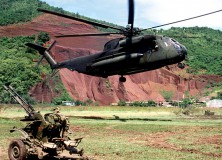Operation Urgent Fury: The 1983 U.S. Intervention in Grenada — Joseph Washecheck

INTRODUCTION:
In October 1983, a leadership crisis within Grenada’s People’s Revolutionary Government spiraled out of control. After the execution of the Prime Minister and the deaths of dozens of civilians, the head of the People’s Revolutionary Army announced the suspension of the civilian government and the establishment of an interim Revolutionary Military Council. He declared a four day, 24 hour shoot-on-sight curfew, trapping some six hundred American medical students on the island. Equipped with only basic information, Washington feared the worst: a mass hostage situation similar to the Iran crisis that plagued the Carter administration. The U.S. response rapidly escalated, culminating in the decision to launch a military operation designed to seize the entire island, evacuate the American students, and restore a democratic government. Leading elements from the U.S. Army Rangers and United States Marine Corps began combat landings on October 25 although the last of the students were not rescued until October 28. Despite this, the operation was successful in that it achieved its objectives: all of the American students were rescued and democratic governance was restored to the island. However, there remains much debate over the legality of the operation, its attendant impact on international law, the real impact on U.S. international relations, and the necessity of the operation.
STRATEGY:
In the early 1980s, the National Security Council system suffered from structural ambiguities that resulted in a complex snarl of responsibilities and occasional lapses of clear leadership. This tendency was exacerbated by the distraction of Cabinet-level authority by the resignation of Reagan’s National Security Advisor on October 14. In the absence of higher authority, the situation in Grenada was dealt with exclusively by the Restricted Interagency Group, an unusual interagency group consisting of representatives from the Department of State, Department of Defense, and CIA. Nominally chaired by the State Department, every member in the group reported individually to their respective departments. No one in the group had clear authority. This early inertia was partially resolved by Cabinet-level involvement beginning on October 20 but by this time the situation in Grenada had become a crisis.
INTEGRATED ELEMENTS OF NATIONAL POWER:
Unity of purpose proved evasive during the early phase of U.S. strategy development – October 13 through October 20 – and the scope of the response continued to be negotiated until at least October 22. Once the decision was made to launch the invasion several flaws in planning and execution became obvious. Fundamental flaws in the intelligence cycle marred the entire operation, demonstrating failures to request and distribute information. The paucity of useful data resulted in an impracticable operational plan calling for a one-day rescue. In the event, the last of the American students on the island was not reached until the third day of combat operations.
EVALUATION:
Several characteristics stand out when considering Urgent Fury. The president was minimally involved in the development of the operation, and clear authorities were often lacking in the Reagan National Security Council system. Ambiguous or absent leadership let a stalemate occur between the bellicose, Reaganite State Department and the reticent, post-Vietnam Defense Department, squandering a significant portion of the early planning period. When Cabinet-level involvement did occur, military conservatism and civilian aggressiveness inflated the American response, turning a limited rescue operation into a full-scale invasion. When an invasion was decided on, excess secrecy in military planning excluded key support agencies and intelligence assets from pre-operation planning. During the conduct of the operation, interservice command, control, and communications protocols proved to be widely divergent. Limited ad hoc solutions were developed to make up for inadequate coordination of command, control, and communications systems between the services.
RESULTS:
Despite the problems faced during the execution of the operation, the mission was a success. The official casualty figures for the operation list 19 Americans dead and 115 wounded. 25 Cubans and 45 Grenadians were killed, with 59 Cubans and 358 Grenadians wounded. According to the Department of Defense, Urgent Fury cost $134.4 million. The intangible results remain the subject of fierce debate. The U.N. General Assembly condemned the action as did British Prime Minister Margaret Thatcher, whose government was angered by the Reagan administration’s failure to consult Downing Street prior to the intervention and severely embarrassed by the American invasion of an independent member of the British Commonwealth. Critics of Operation Urgent Fury occasionally note that, in retrospect, the U.S. students do not appear to have been in any real danger. On the other hand, some analysts claim that the operation significantly curtailed Communist military expansion, serving as a major politico-military Cold War success. Regardless, the problems experienced by the military during the conduct of the operation lent weight to the ongoing Nichols-Goldwater Department of Defense Reorganization Act of 1986.
CONCLUSION:
The situation in Grenada received only intermittent attention from the highest levels until it became an undeniable crisis. In practice, this meant that sharp differences between the Departments of State and Defense were played out in the collegial structure of the Reagan national security decision-making system without recourse to the president to force an early consensus. This highlights the necessity for the NSC system to function smoothly without detailed intervention from the president. However, ultimately, Operation Urgent Fury was a qualified success.